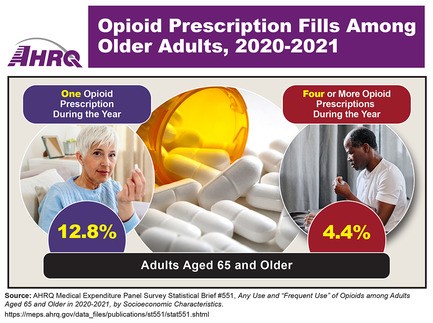Researchers Identify Risk Factors for Pneumonia After Cardiac Surgery
Issue Number
896
January 16, 2024
AHRQ Stats

Access more data on this topic in the associated statistical brief, plus additional AHRQ data infographics.
Today's Headlines:
- Researchers Identify Risk Factors for Pneumonia After Cardiac Surgery.
- AHRQ Antibiotic Stewardship Program Led to Increased Activity, Openness to Change.
- Notice of Intent for AHRQ’s Healthcare Extension Service and Other Agency Funding Opportunities.
- Highlights From AHRQ’s Patient Safety Network.
- AHRQ in the Professional Literature.
Researchers Identify Risk Factors for Pneumonia After Cardiac Surgery
AHRQ-funded researchers identified nine factors that increased a patient’s risk for developing pneumonia following cardiac surgery, including the length of the surgery and the time it takes to remove a breathing tube, according to a study published in The Journal of Thoracic and Cardiovascular Surgery. Postoperative pneumonia, among the most common complications following cardiac surgery, was associated with increased risks of other conditions and death, an average increase in hospital lengths of stay of seven to nine days, and additional healthcare expenditures from $12,000 to $14,000. Researchers studied more than 71,000 records of adult cardiac surgery patients treated between 2011 and 2021 and found that nearly 20 percent of patients moved into a higher pneumonia risk category based on their intraoperative and postoperative course. These findings may inform future quality improvement efforts to reduce patients’ risks of contracting postoperative pneumonia. Access the abstract.
AHRQ Antibiotic Stewardship Program Led to Increased Activity, Openness to Change
Clinicians reported an increased understanding of the importance of antibiotic stewardship and more openness to change their prescribing habits after participating in an AHRQ-sponsored collaborative to improve antibiotic stewardship among neonatal intensive care units (NICUs). A study published in the Journal of Perinatology described how researchers interviewed participants in the Optimizing Antibiotic Stewardship in California NICUs Collaborative, which met regularly from 2021 to 2022, and disseminated nationally recommended antimicrobial interventions among 30 California NICUs by combining quality improvement techniques and the Extension for Community Healthcare Outcomes (ECHO) telehealth learning model. Clinicians reported statistically significant increases in antimicrobial stewardship importance (71 percent vs. 79 percent), perceived antibiotic steward activity (67 percent vs. 87 percent) and more openness to change (59 percent vs. 70 percent) after participating in the collaborative.
Notice of Intent for AHRQ’s Healthcare Extension Service and Other Agency Funding Opportunities
Health services researchers committed to improving the quality, safety and equity of healthcare can explore current and upcoming AHRQ funding opportunities to support this work. A recent Notice of Intent, for example, signals the agency’s plan to publish a funding opportunity announcement to create State-based healthcare extension cooperatives to accelerate the implementation of evidence into practice. The initiative—AHRQ’s Healthcare Extension Service: State-Based Solutions to Healthcare Improvement—will aim to strengthen the capacity of healthcare systems, other healthcare organizations and clinicians to deliver evidence-based care. Sign up for updates on the initiative, which will be funded by the Patient-Centered Outcomes Research (PCOR) Trust Fund, and access more information about PCOR at AHRQ. Other projects for which funding applications are currently being accepted include:
- Systems-Based Approaches to Improve Patient Safety by Improving Healthcare Worker Safety and Well-Being (R01 Clinical Trial Optional).
- AHRQ Understanding and Improving Diagnostic Safety in Ambulatory Care: Incidence and Contributing Factors (R01).
- AHRQ Improving Diagnostic Safety in Ambulatory Care: Strategies and Interventions (R18).
Highlights From AHRQ’s Patient Safety Network
AHRQ’s Patient Safety Network (PSNet) highlights journal articles, books and tools related to patient safety. Articles featured this week include:
- Validity of 16 AHRQ Patient Safety Indicators to identify in-hospital complications: a medical record review across nine Swiss hospitals.
- Measuring the impact of AI in the diagnosis of hospitalized patients: a randomized clinical vignette survey study.
- Changes in hospital adverse events and patient outcomes associated with private equity acquisition.
- Addressing nursing shortages and patient safety using Maslow's hierarchy of needs.
Review additional new publications in PSNet’s current issue or access recent cases and commentaries in AHRQ’s WebM&M (Morbidity and Mortality Rounds on the Web).
AHRQ in the Professional Literature
Priorities for well child care of families affected by parental opioid use disorder. Goyal NK, Sood E, Gannon MA, et al. J Addict Med 2023 Nov 22. [Epub ahead of print.] Access the abstract on PubMed®.
Group well child care for mothers with opioid use disorder: framework for implementation. Goyal N, Gannon M, Sood E, et al. Matern Child Health J. 2023 Dec;27(Suppl 1):75-86. Epub 2023 Jul 29. Access the abstract on PubMed®.
An evidence map for social and structural determinants for maternal morbidity and mortality: a systematic review. Neerland C, Slaughter-Acey J, Behrens K, et al. Obstet Gynecol 2023 Dec 21. [Epub ahead of print.] Access the abstract on PubMed®.
Is there room for individual patient-specified preferences in the patient-reported outcome measurement revolution? Solberg LI, Ziegenfuss JY, Rivard RL, et al. J Patient Cent Res Rev 2023 Fall;10(4):210-8. Epub 2023 Nov 27. Access the abstract on PubMed®.
Sex-based disparities in access to liver transplantation for waitlisted patients with model for end-stage liver disease score of 40. Cron DC, Braun HJ, Ascher NL, et al. Ann Surg 2024 Jan;279(1):112-8. Epub 2023 Jun 27. Access the abstract on PubMed®.
A formal framework for incorporating equity into health care quality measurement. Agniel D, Cabreros I, Damberg CL, et al. Health Aff 2023 Oct;42(10):1383-91. Access the abstract on PubMed®.
Methods for using race and ethnicity in prediction models for lung cancer screening eligibility. Landy R, Gomez I, Caverly TJ, et al. JAMA Netw Open 2023 Sep;6(9):e2331155. Epub 2023 Sep 5. Access the abstract on PubMed®.
Use of electronic communication with clinicians among cancer survivors: Health Information National Trend Survey in 2019 and 2020. Cho Y, Yang R, Gong Y, et al. Telemed J E Health 2023 Jun;29(6):866-74. Epub 2022 Nov 10. Access the abstract on PubMed®.



